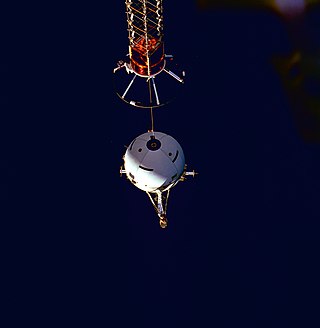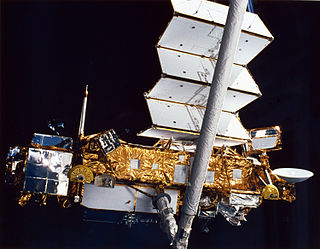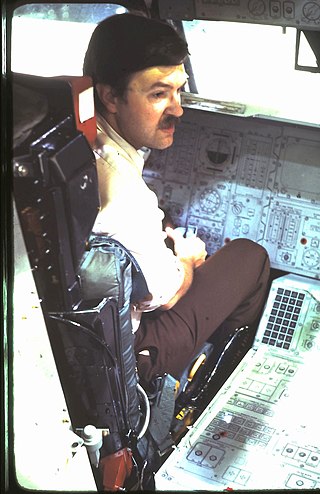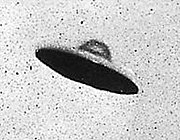
An unidentified flying object (UFO), or unidentified anomalous phenomenon (UAP), is any perceived airborne, submerged or transmedium phenomenon that cannot be immediately identified or explained. Upon investigation, most UAPs are identified as known objects or atmospheric phenomena, while a small number remain unexplained.

The George C. Marshall Space Flight Center (MSFC), located in Redstone Arsenal, Alabama, is the U.S. government's civilian rocketry and spacecraft propulsion research center. As the largest NASA center, MSFC's first mission was developing the Saturn launch vehicles for the Apollo program. Marshall has been the lead center for the Space Shuttle main propulsion and external tank; payloads and related crew training; International Space Station (ISS) design and assembly; computers, networks, and information management; and the Space Launch System. Located on the Redstone Arsenal near Huntsville, MSFC is named in honor of General of the Army George C. Marshall.
Donald Edward Keyhoe was an American Marine Corps naval aviator, writer of aviation articles and stories in a variety of publications, and tour manager of aviation pioneer Charles Lindbergh.
UFO conspiracy theories are a subset of conspiracy theories which argue that various governments and politicians globally, in particular the United States government, are suppressing evidence that unidentified flying objects are controlled by a non-human intelligence or built using alien technology. Such conspiracy theories usually argue that Earth governments are in communication or cooperation with extraterrestrial visitors despite public disclaimers, and further that some of these theories claim that the governments are explicitly allowing alien abduction.

STS-7 was NASA's seventh Space Shuttle mission, and the second mission for the Space Shuttle Challenger. During the mission, Challenger deployed several satellites into orbit. The shuttle launched from Kennedy Space Center on June 18, 1983, and landed at Edwards Air Force Base on June 24, 1983. STS-7 carried Sally Ride, America's first female astronaut.

Space debris are defunct human-made objects in space – principally in Earth orbit – which no longer serve a useful function. These include derelict spacecraft, mission-related debris, and particularly-numerous in-Earth orbit, fragmentation debris from the breakup of derelict rocket bodies and spacecraft. In addition to derelict human-made objects left in orbit, space debris includes fragments from disintegration, erosion, or collisions; solidified liquids expelled from spacecraft; unburned particles from solid rocket motors; and even paint flecks. Space debris represents a risk to spacecraft.

Edgar Dean "Ed" Mitchell was a United States Navy officer and aviator, test pilot, aeronautical engineer, ufologist, and NASA astronaut. As the Lunar Module Pilot of Apollo 14 in 1971 he spent nine hours working on the lunar surface in the Fra Mauro Highlands region, and was the sixth person to walk on the Moon. He was the second Freemason to set foot on the Moon, after Buzz Aldrin.

STS-75 was a 1996 NASA Space Shuttle mission, the 19th mission of the Columbia orbiter.

The Kecksburg UFO incident occurred on December 9, 1965, at Kecksburg, Pennsylvania, United States, when a fireball was reported by citizens of six U.S. states and Canada over Detroit, Michigan, and Windsor, Ontario. Astronomers said it was likely to have been a meteor bolide burning up in the atmosphere and descending at a steep angle. NASA released a statement in 2005 reporting that experts had examined fragments from the area and determined they were from a Soviet satellite, but that records of their findings were lost in 1987. NASA responded to court orders and Freedom of Information Act requests to search for the records. The incident gained wide notoriety in popular culture and ufology, with speculation ranging from extraterrestrial craft to debris from the Soviet space probe Kosmos 96, and is often called "Pennsylvania's Roswell".

STS-48 was a Space Shuttle mission that launched on September 12, 1991, from Kennedy Space Center, Florida. The orbiter was Space ShuttleDiscovery. The primary payload was the Upper Atmosphere Research Satellite (UARS). The mission landed on September 18 at 12:38 a.m. EDT at Edwards Air Force Base on runway 22. The mission was completed in 81 revolutions of the Earth and traveled 3,530,369 km (2,193,670 mi). The 5 astronauts carried out a number of experiments and deployed several satellites. The total launch mass was 108,890 kg (240,060 lb) and the landing mass was 87,440 kg (192,770 lb).
Richard Charles Hoagland, is an American author and a proponent of various conspiracy theories about NASA, lost alien civilizations on the Moon and on Mars and other related topics. Hoagland has been documented to misappropriate others' professional achievements and is widely described as a conspiracy theorist and pseudoscientist.
The extraterrestrial hypothesis (ETH) proposes that some unidentified flying objects (UFOs) are best explained as being physical spacecraft occupied by extraterrestrial intelligence or non-human aliens, or non-occupied alien probes from other planets visiting Earth.

NASA's series of Great Observatories satellites are four large, powerful space-based astronomical telescopes launched between 1990 and 2003. They were built with different technology to examine specific wavelength/energy regions of the electromagnetic spectrum: gamma rays, X-rays, visible and ultraviolet light, and infrared light.

The Flying Saucers Are Real by Donald Keyhoe, was a book that investigated reports of UFOs by United States Air Force fighters, personnel, and other aircraft, between 1947 and 1950.

James Edward Oberg is an American space journalist and historian, regarded as an expert on the Russian and Chinese space programs. He had a 22-year career as a space engineer in NASA specializing in orbital rendezvous. Oberg is an author of ten books and more than a thousand articles on space flight. He gave many explanations of UFO phenomena in the popular press. He is also a consultant in spaceflight operations and safety.

The Wild Blue Yonder is a 2005 science fiction fantasy film by German director Werner Herzog. It was presented at the 62nd Venice Film Festival, where it won the FIPRESCI Award. It was screened in competition at the Mar del Plata International Film Festival and the Sitges Film Festival, winning the "Carnet Jove – Special Mention" award at the latter. Most of the film consists of recontextualized documentary footage which is overlaid with fictional narration. This technique was used in Herzog's earlier film Lessons of Darkness (1992).
The Hollow Moon and the closely related Spaceship Moon are pseudoscientific hypotheses that propose that Earth's Moon is either wholly hollow or otherwise contains a substantial interior space. No scientific evidence exists to support the idea; seismic observations and other data collected since spacecraft began to orbit or land on the Moon indicate that it has a thin crust, extensive mantle and small, dense core. Overall it is much less dense than Earth.
UFO sightings in outer space are sightings of unidentified flying objects reported by astronauts while in space that they could not explain at the time. These sightings have been claimed as evidence for alien visits by ufologists.

The Flying Saucer Conspiracy is a 1955 book authored by early UFO researcher Donald Keyhoe. The book pointedly accused elements of United States government of engaging in a conspiracy to cover up knowledge of flying saucers. Keyhoe claims the existence of a "silence group" of orchestrating this conspiracy.
The Galileo Project is an international scientific research project to systematically search for extraterrestrial intelligence or extraterrestrial technology on and near Earth and to identify the nature of anomalous Unidentified Flying Objects/Unidentified Aerial Phenomena (UFOs/UAP).















